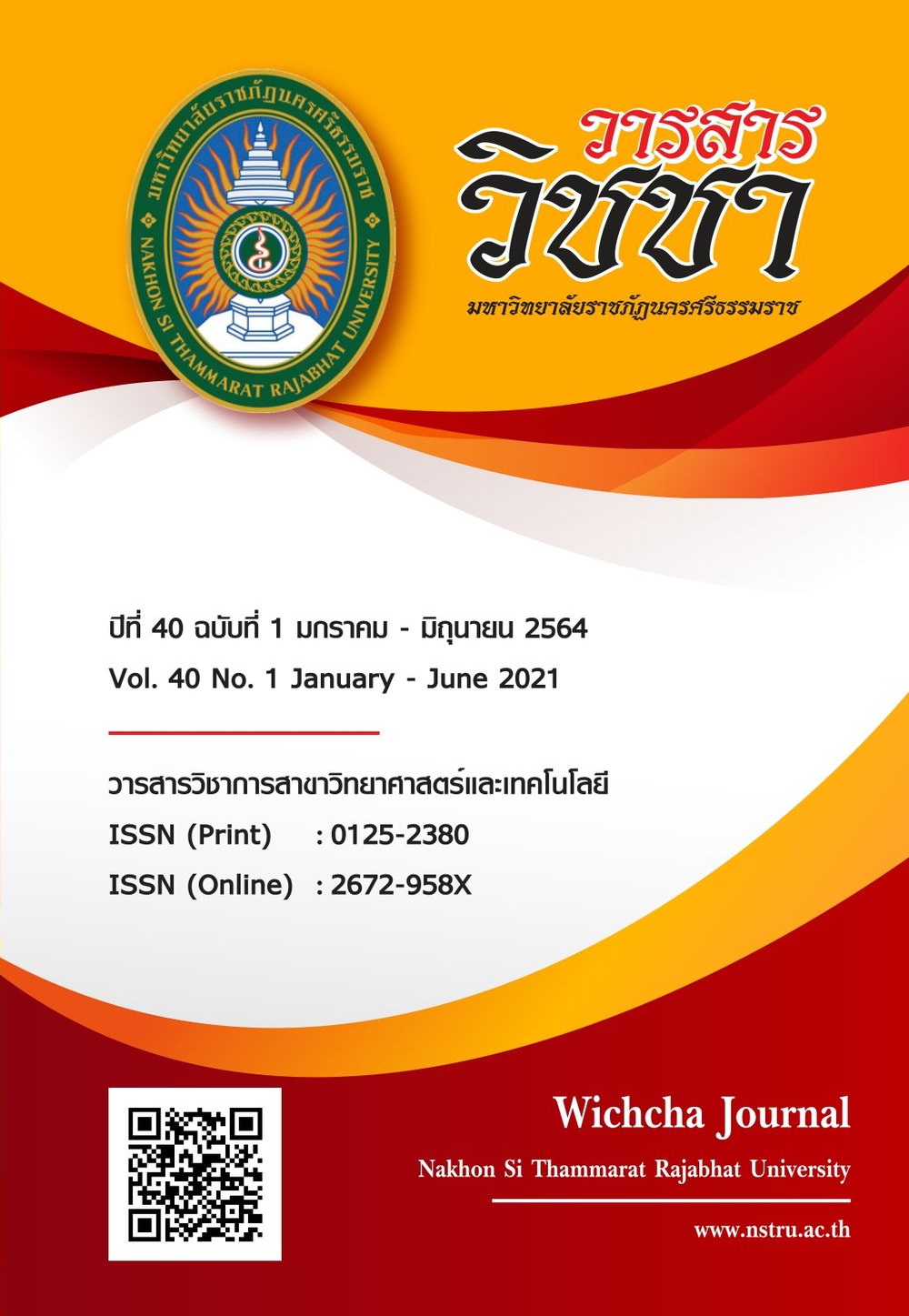Effect of Agitation and Aeration on the Growth of Aurantiochytrium sp. FIKU018 Fed-batch Cultured in Bioreactor ผลของอัตราการกวนและการให้อากาศต่อการเจริญเติบโตของ Aurantiochytrium sp. FIKU018 ที่เพาะเลี้ยงแบบเฟด-แบทช์ ในถังปฏิกรณ์ชีวภาพ
Main Article Content
Abstract
Agitation and aeration are important factors, which play a vital role in cell characteristics and cell growth during cultivation in the bioreactor. This research aimed to study the effects of agitation and aeration rates on the growth of Aurantiochytrium sp. FIKU018 cultured in the fermenter. The fed-batch cultivation of Aurantiochytrium sp. FIKU018 was conducted in a 22 L bioreactor, feeding with GYP medium in batch phase and with GYP feed and glucose feed during the fed-batch stage. The process was operated at 30°C, pH 6.0 under different agitation (450-800 rpm) and aeration (0-1.5 vvm) rates. The sample was collected every 4 h to measure the absorbance, determine dry cell weight and analyze the concentration of reducing sugar. The results showed that the stirring rate of 450 rpm and associated with an appropriate aeration rate, which adjusted according to the cell growth was proper to enabled the fed-batch cell culture to continue for 64 h with the specific growth rate of 0.21 h-1 and the maximum dry cell weight of 30.50±0.44 g/L. The yield at the end of the culture in the fed-batch system was 0.45±0.05 g cell/g glucose. This finding can be used as fundamental data to develop Aurantiochytrium sp. FIKU018 cultivation in the bioreactor for further upscale to the industrial level.
Article Details
เนื้อหาและข้อมูลในบทความที่ลงตีพิมพ์ในวารสารวิชชา มหาวิทยาลัยราชภัฏนครศรีธรรมราช ถือเป็นข้อคิดเห็นและความรับผิดชอบของผู้เขียนบทความโดยตรง ซึ่งกองบรรณาธิการวารสารไม่จำเป็นต้องเห็นด้วยหรือร่วมรับผิดชอบใด ๆ
บทความ ข้อมูล เนื้อหา รูปภาพ ฯลฯ ที่ได้รับการตีพิมพ์ในวารสารวิชชา มหาวิทยาลัยราชภัฏนครศรีธรรมราช ถือเป็นลิขสิทธ์ของวารสารวิชชา มหาวิทยาลัยราชภัฏนครศรีธรรมราช หากบุคคลหรือหน่วยงานใดต้องการนำข้อมูลทั้งหมดหรือส่วนหนึ่งส่วนใดไปเผยแพร่ต่อหรือเพื่อการกระทำการใด ๆ จะต้องได้รับอนุญาตเป็นลายลักษณ์อักษรจากวารสารวิชชา มหาวิทยาลัยราชภัฏนครศรีธรรมราชก่อนเท่านั้น
The content and information in the article published in Wichcha journal Nakhon Si Thammarat Rajabhat University, It is the opinion and responsibility of the author of the article. The editorial journals do not need to agree. Or share any responsibility.
References
เทพปัญญา เจริญรัตน์ และวรสิทธิ์ โทจำปา. (2553). ปฏิบัติการเทคโนโลยีการหมัก. ปทุมธานี: โรงพิมพ์มหาวิทยาลัยธรรมศาสตร์.
Chang, G., Gao, N., Tian, G., Wu, Q., Chang, M. and Wang, X. (2013). Improvement of docosahexaenoic acid production on glycerol by Schizochytrium sp. S31 with constantly high oxygen transfer coefficient. Bioresource Technology, 142, 400-406.
Chatdumrong, W., Yongmanitchai, W., Limtong, S. and Worawattanamateekul, W. (2007). Optimization of docosahexaenoic acid (DHA) production and improvement of astaxanthin content in a mutant Schizochytrium limacinum isolated from mangrove forest in Thailand. Kasetsart Journal (Natural Science), 41(2), 324-334.
Chi, Z., Liu, Y., Frear, C. and Chen, S. (2009). Study of a two-stage growth of DHA-producing marine algae Schizochytrium limacinum SR21 with shifting dissolved oxygen level. Applied Microbiology Biotechnology, 81(6), 1141-1148.
Chin, H.J., Shen, T.F., Su, H.P. and Ding, S.T. (2006). Schizochytrium limacinum SR-21 as a source of docosahexaenoic acid: optimal growth and use as a dietary supplement for laying hens. Australian Journal of Agricultural Research, 57(1), 13-20.
Honda, D., Yokochi, T., Nakahara, T., Erata, M. and Higashihara, T. (1998). Schizochytrium limacinum sp. nov., a new thraustochytrid from a mangrove area in the west Pacific Ocean. Mycological Research, 102(4), 439-448.
Jakobsen, N.A., Aasen, M.I., Josefsen, D.K. and Strøm, R.A. (2008). Accumulation of docosahexaenoic acid-rich lipid in thraustochytrid Aurantiochytrium sp. strain T66: effects of N and P starvation and O2 limitation. Applied Microbiology Biotechnology, 80(2), 297-306.
Nagano, N., Taoka, Y., Honda, D. and Hayashi, M. (2009). Optimization of culture conditions of growth and docosahexaenoic acid production by a marine Thraustochytrid, Aurantiochytrium limacinum mh0186. Journal of Oleo Science, 58(12), 623-628.
Qu, L., Ji, J.X., Ren, J.L., Nie, K.Z., Feng, Y., Wu, J.W., Ouyang, K.P. and Huang, H. (2010). Enhancement of docosahexaenoic acid production by Schizochytrium sp. using a two-stage oxygen supply control strategy based on oxygen transfer coefficient. Letter in Applied Microbiology, 52(1), 22-27.
Raghukumar, S. (2008). Thraustochytrid marine protists: production of PUFAs and other emerging technologies. Marine Biotechnology, 10(6), 631-640.
Ren, J.L., Ji, J.X., Huang, H., Qu, L., Feng, Y., Tong, Q.Q. and Ouyang, K.P. (2010). Development of stepwise aeration control strategy for efficient docosahexaenoic acid production by Schizochytrium sp. Applied Microbiology Biotechnology, 87(5), 1649-1656.
Romeu-Nadal, M., Castellote, A.I., López-Sabater, M.C. (2008). Effect of cold storage on vitamins C and E and fatty acids in human milk. Food Chemistry, 106(1), 65-70.
Song, X., Zang, X. and Zhang, X. (2015). Production of high docosahexaenoic acid by Schizochytrium sp. using low-cost raw materials from food industry. Journal of Oleo Science, 64(2), 197-204.
Yaguchi T., Tanaka S., Yokochi T., Nakahara T., Higashihara T. (1997). Production of high yields of docosahexaenoic acid by Schizochytrium sp. strain SR21. Journal of the American Oil Chemists’ Society, 74(11), 1431-1434.
Yokoyama, R. and Honda, D. (2007). Taxonomic rearrangement of the genus Schizochytrium sensu lato based onmorphology, chemotaxonomic characteristics, and 18S rRNA gene phylogeny (Thraustochytriaceae, Labyrinthulomycetes): emendation for Schizochytrium and erection of Aurantiochytrium and Oblongichytrium gen. nov. Mycoscience, 48(4), 199-211.
Zeng, Y., Ji, X.J, Lian, M., Ren, L.J., Jin, L.J, Ouyang, P.K. and Huang, H. (2011). Development of a temperature shift strategy for efficient docosahexaenoic acid production by a marine fungoid protist, Schizochytrium sp. HX-308. Applied Biochemistry and Biotechnology, 164(3), 249-255.


